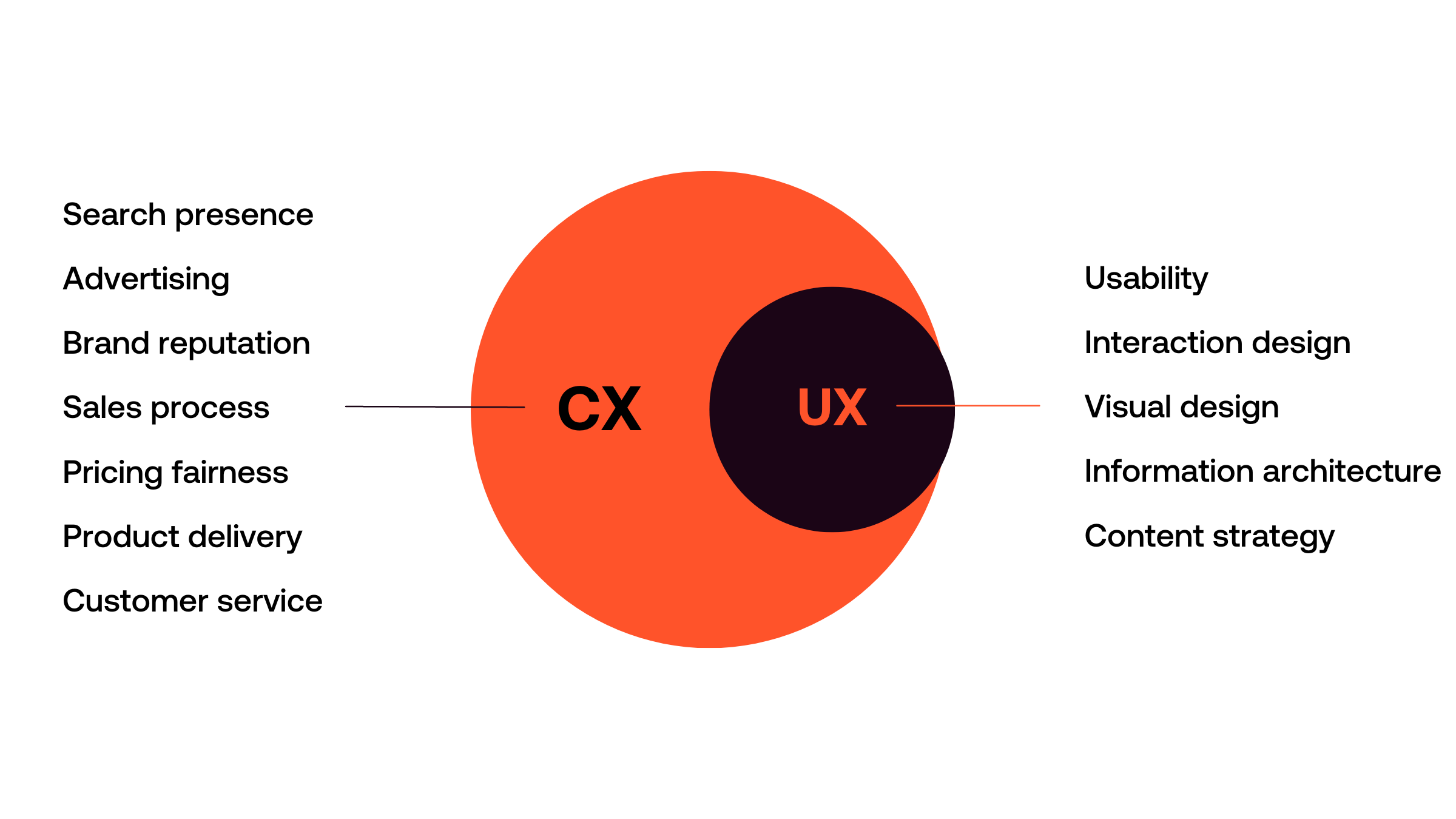
What is Digital Customer Experience Benchmarking and why is it important?
A unique opportunity to outsmart the competition and win a greater market share.
Winning customers is hard, and keeping them can be even harder. Your competition isn’t merely sitting idle – they’re constantly working behind closed doors to outsmart and outperform. They’re always looking for ways to steal customers from their competition.
That’s you.
Retaining loyal customers can seem almost impossible in a competitive market; there’s always a wide array of attractive competing offers ready to lure away your customers. However, with digital Customer Experience (CX) benchmarking, you have a unique opportunity to outsmart the competition and win a greater market share.
Let’s look at how you can gain this edge by using digital CX benchmarking to optimize your experience and offer.
What is your digital CX?
Imagine yourself standing in a busy place: an airport or shopping mall, for example. If you look around, what do you see? Provided you’re still in the early 21st century, there’s a good chance everyone will be holding their phone or another digital device firmly in their hand.
They might look up (just occasionally) to steer their physical body in the right direction before returning to their real journey – the digital one.
The evidence is concrete: today’s customer – whether business customer or consumer – is experiencing their world in a ‘digital-first’ way. Crucially, for businesses, this means the digital customer experience is the most important – and it deserves your utmost attention if you want to intercept and retain customers.
If they can do it – why not you?
There is an extra dimension to consider about the way people experience the digital world: They see it all as one experience – their own.
As we explore our digital world, we are subconsciously and continuously benchmarking our experiences ourselves. Throughout the day we experience numerous different websites and apps; from the biggest brands like Netflix, Uber, Facebook, Apple, to the very smallest brands (with a much smaller budget).
Each of these digital experiences creates an expectation that rolls over to our next one, even when they are not at all connected.
These expectations are continuously changing; as we experience better experiences, the bar is raised. Each subsequent experience is compared to this new benchmark.
This shows just how important it is to keep a constant eye on how your CX is seen by the customer. Because they’re not just looking at you, and their expectations keep going up.
UX vs. CX – what’s the difference?
There is much confusion between user experience (UX) and customer experience (CX) – is there a difference? The answer is yes.
The UX is just one aspect of the whole CX; while the UX describes interactions and experiences of using your product or service (including website features), the CX encompasses much more.

Your digital CX consists of every digital touchpoint the customer has with your brand and offer. Currently, the vast majority of the digital CX takes place on your company website. It can, however, also include other digital interactions such as apps and social media.
Having an optimized CX is a competitive edge you cannot afford to lose. With even the best offer on the market, an underperforming CX can translate to a shrinking market share. An optimized digital CX, on the other hand, can give you the leading edge on the competition and increase your share of the market.
Why is your digital CX so important today?
When the internet was new, it was considered ‘enough’ for a business to put a few lines of explanatory text on a page with a phone number or email address – maybe both. Because barely anyone used the internet or really knew what to do with it. The US Postal Service website from 1997 is a perfect example of how digital experiences have evolved massively from the ‘barely there’ to ‘always on’.
The dominance of the digital world and digital customer experiences means two things: Firstly, it’s easier than ever to reach new customers. And secondly, it’s easier than ever for them to go to the competition if their digital experience is better.
An abundance of choice
Your entire CX must be seen as a chain leading to conversion. Each stage in the journey is a link in that chain. If one part of the customer’s digital journey falls short, this weak link will affect the entire experience.
As far as the customer is concerned, you’re only as good as the weakest element of your CX.
Customers have an abundance of choice, and they know it. All it takes is a quick scroll or a swipe, and your chance has passed. There’s strong pressure to make sure every part of your CX is better than the most relevant competition, or you will lose to them.
Positive emotions
Emotion plays a considerable role in the customer’s decision to stay on a page or give up from frustration or uncertainty. The experience must fulfill and exceed their expectations; offering all the information they need without overwhelming. The digital customer experience must offer an environment that makes them feel welcome and confident, and give them reassurance that their decision to use your product or service is the right one.
Like any physical brand experience, your digital customers don’t keep coming back to your website or store just because they remembered how to get there. They choose to – because the experience is better. And, if it wasn’t, they would go somewhere else.
The problem is you would never know this had happened.
Until now.
Benchmarking: What is it?
The customer perspective is what really matters – because they’re the decision makers. Benchmarking can give you an unparalleled vision of the customer perspective, and show how you can change their opinion in your favor.
Benchmarking is essentially any comparison based on a ‘defined standard’ (the benchmark). In its simplest form, it can entail comparing one set of data or measurement against another, however, when it comes to the digital customer experience this becomes more complex and nuanced.
First, there are two main kinds of benchmarking: internal benchmarking, and external benchmarking.
Internal benchmarking
Key Performance Indicators (KPIs) are an internal benchmark that we’re all familiar with, but internal benchmarking can also be based on other data or predefined ‘standards.’
Internal benchmarking is intrinsically limited because it only draws on a company’s own historical data, or compares this to an ‘industry standard’ or ‘sector average.’ However, internal benchmarking is far from being useless. This kind of benchmarking can tell you a lot about changes in your own performance over time, and it can demonstrate the effects of implementing specific solutions or initiatives, compared to a baseline value.
To use internal benchmarking effectively however, it should be guided by external benchmarking that tells you what targets you need to aim for. Knowing that your bounce rate is ‘higher than the average’ or ‘higher than last month’ does not tell you why, or what needs to be done to fix it. For that, you need external benchmarking.
External benchmarking
External benchmarking is the most impactful kind of benchmarking for your digital CX. It compares your performance data against the same kind of data from your most relevant competition, using a standardized technique and methodology that guarantees you’re comparing ‘like for like’.
When external benchmarking is done well, it can illuminate hidden truths about your own performance and pin down specific changes that can make a difference. External benchmarking can tell you how your competition is stealing customers from you by identifying what they are doing better – according to the customer. To do this well, the data-gathering and processing must be well-designed and reliably executed, using the largest data sets possible.
What external benchmarking can do for your digital CX performance
What if you always knew how you were losing customers, and what you needed to fix it? Let’s look at some specific ways that using an external benchmark can help optimize your digital CX.

Always know how you measure up
To win, you must stay ahead of the competition.
OK, that’s the obvious part – but what isn’t so obvious is where you measure-up right now.
Internal metrics cannot give you this vision, but external benchmarking can.
External benchmarking gives you a continuous vision of your relative performance and tells you what the competition is doing better. This makes sure you can keep your position by knowing what must improve today to win customers from your competition.
Of course, winning today is good, but if your competition optimizes faster than you, then you can start losing your market share.
Without external benchmarking you wouldn’t know this was happening, where your customers were going instead, or why.
By using external CX benchmarking regularly, you can continuously track how you measure-up in the eye of the customer. You also gain an understanding of the rationale behind their assessment, using qualitative data and open answers. WUA’s benchmarking studies go into the deep details of customer experiences, and uncover deeper insights about the whole experience.
This analysis is done for every stage of the customer journey to ensure that every part is better than the competition. It doesn’t have to be miles better for the customer to choose you – just better than the alternative.
You can determine their ‘turn offs’ and learn what it takes to win their custom instead of losing to a competitor. Benchmarking also helps you identify what you’re doing well at – and what doesn’t need changed. This can save expensive and misguided ‘optimizations,’ and help you keep what’s working.
Prioritize UX backlogs
The chances are that you already have a ‘UX fix’ backlog from the issues identified from your own data. Internal website metrics, like bounce rates, visitor numbers, session length, time on page, and click-through-rates, have all generated a significant to-do list for your web development team.
Digital CX benchmarking helps you prioritize these tasks, targeting what really counts. It can tell you which optimizations will have the greatest impact on CX and conversion, meaning your #1 task is always crystal-clear.
Before, perhaps you knew that you had a high cart abandonment rate (compared to sector average), but with external CX benchmarking you can see why, and which steps need to be changed. A gradual tightening-up of the UX, step by step, addressing the most impactful priorities first will get better results faster.
Total vision of the customer journey
Your customers are on a journey; just a single bump can throw them off-course and send them elsewhere. With a total vision of each stage of their journey, each step leads gracefully to the next – no stumbling or missteps. The entire customer journey becomes a smooth one with a vision of how each stage leads to the next, ending in successful conversion.
Uncover UX optimizations you didn’t know about
Website metrics can only measure the success of what’s already there, and only compared to previous data or an arbitrary average. With CX benchmarking, you can discover features that you lack entirely, and uncover UX fixes that you didn’t know about because you’re not able to measure them.
Reduce customer churn
Customers are hard to win, but easy to lose. Benchmarking against your competitors makes it possible to see what motivates them to choose a competitor instead, and undermine it with a superior offer or experience.
Data to support confident decision making
We’re talking about money here. Spending resources on optimizations is easier to justify with data that shows what the impact is. Knowing that your competition is doing better at ‘X’ than you, and that this translates to a bigger market share, it’s a no-brainer to justify the decision to also do ‘X’ (but better). Data is something you can take to the boardroom or management meeting to demonstrate the impact of each optimization on ROI.
A mirror on your whole enterprise and a vision of the future
The benefits of digital CX benchmarking extend far beyond optimizing what you do now. The holistic vision generated from a total market overview can show you what you’re missing.
Benchmarking can extract in-depth and qualitative data that acts like a mirror on your whole enterprise. It makes it possible to identify common demands and expectations you’re not meeting, and this can drive improvements in product development too.
Benchmarking is the ultimate market intelligence. It delivers more specific and granular benefits than data about customer trends ever could. Your business doesn’t need anything more than a clear picture of where you stand now, and what you need to do today to get the best results tomorrow.
It’s knowledge that you can use; something that translates into better results.
Grow faster than the market
- Gain a profound understanding of the key investments driving significant growth in your online sales.
- Attain a comprehensive overview of the dynamic digital landscape, enabling early detection of potential threats.
- Assess customer conversion rates with precision and measure your performance against competitors effectively.

